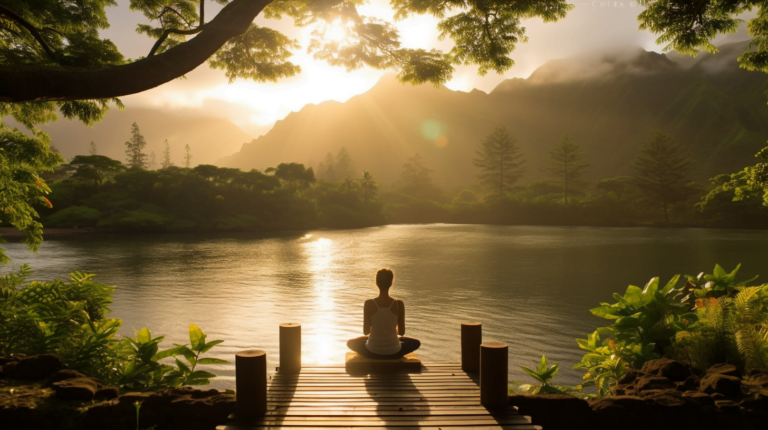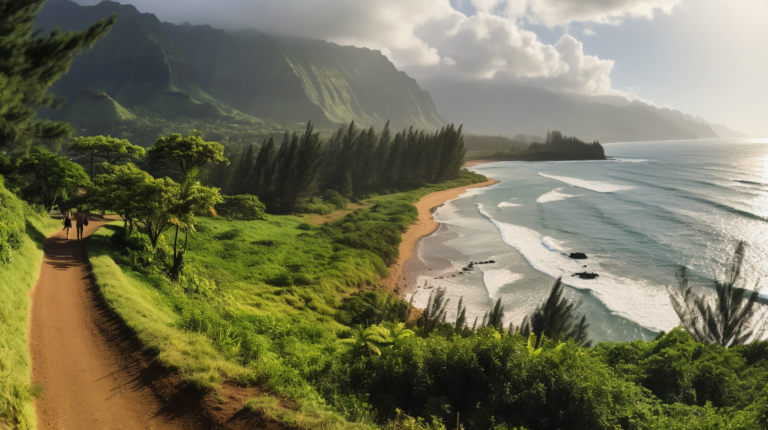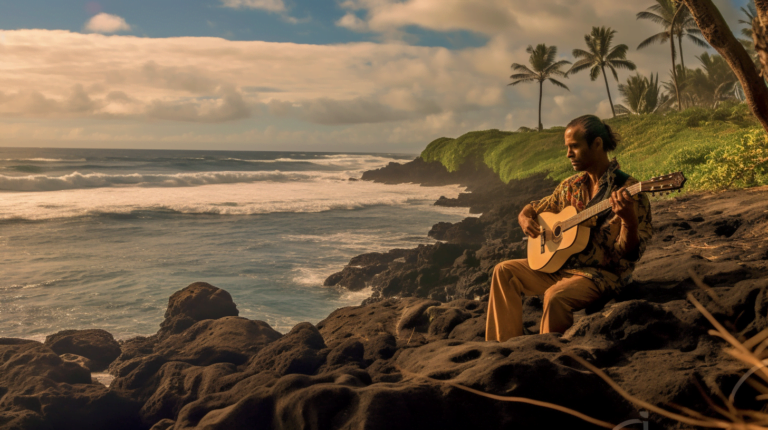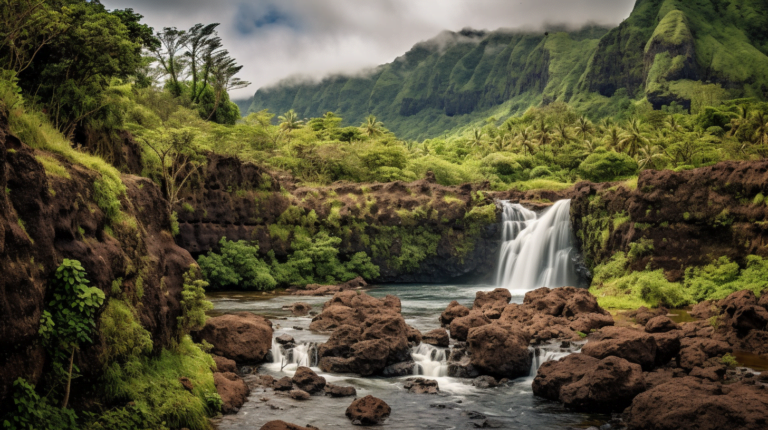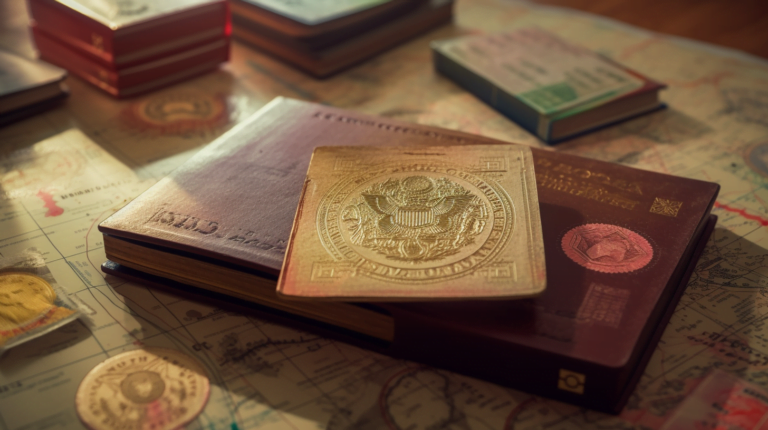🌺 Embracing the Spirit of Aloha: Exploring Traditional Kauai’s Rich Native Hawaiian Culture 🌴
You step off the plane onto the lush island of Kauai, surrounded by the crystal-clear waters of the Pacific Ocean. You can feel the warm sun on your skin and smell the sweet scent of plumeria in the air.
As you make your way around the island, you can’t help but feel a sense of wonder and curiosity about the native Hawaiian culture that has thrived here for centuries.
Traditional Kauai offers a glimpse into the rich history and traditions of the Hawaiian people. From the importance of land in their culture to the language and communication style unique to the islands, there is much to learn and appreciate.
As you delve deeper into this fascinating world, you’ll discover the arts and crafts, food and drink, music and dance, and historical sites that have shaped the culture of Kauai and the Hawaiian Islands as a whole.
So, grab your lei and get ready to explore the beauty and richness of traditional Kauai.
Key Takeaways
- Native Hawaiian culture is deeply rooted in the language, communication, and connection between people and the environment.
- Traditional arts, crafts, food, music, dance, and historical sites shape the culture of Kauai and the Hawaiian Islands, which are undergoing a revival and preservation of their language and traditions.
- The natural beauty of Kauai’s Waimea Canyon and Na Pali Coast offers breathtaking views and opportunities for visitors to connect with the island’s unique perspectives and values.
- Kauai serves as a hub for community-based cultural preservation efforts, including hula performances, lei-making classes, and festivals that celebrate the island’s unique music, dance, and arts.
The Importance of Land in Native Hawaiian Culture
You’ll quickly realize that land holds immense significance in Native Hawaiian culture. The connection to ancestry is deeply rooted in the land, as it’s believed that the gods and ancestors reside within it.
The spiritual significance of the land is also a key aspect of the culture, as it’s seen as a source of life and sustenance. The land is not just a physical space, but a sacred and spiritual one that must be respected and cared for.
The importance of land is also reflected in the language and communication of Native Hawaiians. Many words and phrases in the Hawaiian language are tied to the land and reflect the deep connection between the people and their environment.
For example, the word for family, ‘ohana,’ is derived from the word for taro, a staple crop that’s grown in the land. This connection to the land is a fundamental aspect of Native Hawaiian culture and serves as a reminder of the importance of preserving and protecting it for future generations.
Language and Communication
When speaking with locals, it’s common to hear Hawaiian words mixed in with English, like how a chef might add a pinch of salt to enhance the flavor of a dish. This is a reflection of the ongoing Hawaiian language revival, in which efforts are being made to preserve and promote the language.
In addition to being a means of communication, the language is also an important part of the culture, as it is tied to many traditional practices and beliefs. There are cultural exchange programs that offer visitors the opportunity to learn more about the language and its significance, as well as to practice speaking with native speakers.
Learning about the language can also provide insight into the unique perspectives and values held by the native Hawaiian community. For example, the language has a rich vocabulary for describing the natural environment, reflecting the deep connection that Hawaiians have to their land and sea.
Understanding these nuances can help visitors appreciate the depth and complexity of the culture. As we move on to the next section about arts and crafts, it’s important to keep in mind that these forms of expression are also intertwined with language and communication, as they’re often used to convey stories and traditions.
Arts and Crafts
Get ready to discover the vibrant creativity of local artisans and their unique crafts, adding to the island’s rich cultural tapestry.
Traditional Kauai is known for its stunning handmade jewelry, woven using ancient techniques passed down through generations. The intricate designs and colorful patterns are a testament to the skill and dedication of these talented artisans. Weaving techniques are also used to create beautiful baskets, mats, and hats. These items not only serve a practical purpose but also showcase the artistry of the weaver.
As you explore the many craft fairs and markets on the island, you’ll have the opportunity to meet these skilled artisans and learn more about their craft. From delicate jewelry to sturdy woven baskets, the arts and crafts of Traditional Kauai are a sight to behold.
As you finish admiring the intricate designs and workmanship of these crafts, it’s time to move on to the next aspect of Traditional Kauai: food and drink.
Food and Drink
Indulge in the mouthwatering flavors of local cuisine and refreshing drinks that will leave you craving more. Kauai’s culinary traditions reflect the island’s diverse history and cultural influences, resulting in a unique blend of flavors and cooking techniques.
From succulent seafood dishes like poke and grilled mahi-mahi, to hearty kalua pork and poi, there’s something to satisfy every palate. The use of local ingredients, such as taro, coconut, and pineapple, adds a special touch to each dish, making them truly authentic and unforgettable.
As you savor each bite, you’ll also want to try some of the island’s refreshing drinks. Made with fresh fruit and local ingredients, these drinks are the perfect way to cool off on a hot day. Try a classic mai tai or a refreshing coconut water, or indulge in a unique concoction like lilikoi (passionfruit) juice or a Kauai sunrise, made with locally-grown coffee.
With so many delicious options to choose from, you’ll want to sample them all.
Now, let’s move on to the next section where we’ll explore Kauai’s vibrant music and dance scene.
Music and Dance
As you delve into the world of Hawaiian music and dance, you’ll discover a rich and vibrant history behind the hula. This traditional dance form has been a part of Hawaiian culture for centuries, with different styles and interpretations emerging over time.
Additionally, you’ll learn about the unique instruments used in traditional Hawaiian music. These include the ukulele, steel guitar, and slack key guitar, which have all contributed to the distinct sound of this beautiful island culture.
History of Hula
You can almost feel the rhythm of the waves and see the swaying of the palm trees as you learn about the rich history of hula, a traditional dance that has been passed down through generations of Native Hawaiians.
Hula origins can be traced back to the ancient Polynesians who first settled in Hawaii. Their dances were religious and ceremonial, used to honor their gods and goddesses, and were often accompanied by chanting and rhythmical beats.
Over time, hula evolved into a storytelling dance, where the dancers would use gestures and movements to tell stories of their culture and history. It became a way to pass down traditions and values to the younger generations, and is still regarded as an important part of the Native Hawaiian culture today.
The cultural significance of hula is undeniable, and it continues to be celebrated and preserved through performances and competitions.
Now, let’s move on to the next topic and learn about the traditional musical instruments that accompany hula.
Traditional Musical Instruments
Get ready to experience the authentic sounds of hula with the use of traditional musical instruments.
The history and evolution of these instruments is deeply intertwined with the culture and traditions of the Native Hawaiian people.
The most well-known of these instruments is the ukulele, which originated in Hawaii in the late 19th century and has since become a symbol of Hawaiian music worldwide.
Other traditional instruments include the ipu, a gourd drum that is used to keep rhythm in hula dances, and the pahu, a large drum made from a hollowed-out tree trunk that is used in traditional chants and dances.
These instruments have been passed down through generations of Native Hawaiians, and while modern adaptations have been made, the traditional versions are still used in many performances today.
Now, let’s dive into the historical sites that showcase the rich history and culture of Kauai.
Historical Sites
Visiting the ancient heiaus and petroglyphs on Kauai’s north shore feels like stepping back in time to witness the rich history of Native Hawaiian culture. These historical sites are not just remnants of the past, but they’re also crucial to the cultural significance of the island.
The heiaus, in particular, were sacred places of worship and refuge for the Hawaiians, and their historical preservation is a testament to their religious and cultural beliefs.
The petroglyphs, on the other hand, are ancient rock carvings that depict various aspects of Hawaiian life. They’re believed to be created by the ancestors of the Hawaiians, and their preservation serves as a link to the past.
The intricate designs and symbols etched into the rocks are a testament to the artistic and creative abilities of the Hawaiian people. These historical sites are a must-visit for those who want to learn more about the rich cultural heritage of Kauai.
Now, let’s move on to the next section about the natural wonders of Kauai.
Natural Wonders
As you explore Kauai’s natural wonders, you’ll want to make sure to visit two iconic locations – Waimea Canyon and Na Pali Coast.
Waimea Canyon, often called the ‘Grand Canyon of the Pacific,’ stretches 14 miles long and over 3,000 feet deep, offering breathtaking views of vibrant reds and greens.
Meanwhile, Na Pali Coast’s dramatic cliffs, secluded beaches, and crystal-clear waters provide the perfect backdrop for a scenic hike or boat ride.
Don’t miss out on these unforgettable experiences during your visit to Kauai.
Waimea Canyon
Exploring Waimea Canyon is an unforgettable experience, offering breathtaking views and a deeper connection to the natural beauty of traditional Kauai. The hiking trails wind through the lush greenery, giving you the opportunity to witness the stunning scenery up close. As you trek along the paths, you’ll be mesmerized by the colorful rock formations, towering waterfalls, and cascading streams. The canyon is a true testament to the power and beauty of Mother Nature.
The scenic views from Waimea Canyon will leave you in awe, with panoramic vistas that stretch out for miles. From the lookout points, you can see the deep reds and oranges of the canyon walls, contrasted against the vibrant greens of the foliage. As the sun sets, the canyon takes on a new life, with the colors deepening and the shadows lengthening. It’s truly a sight to behold, and one that will stay with you for a lifetime.
As you continue your journey through traditional Kauai, the next stop on your adventure is the stunning Na Pali Coast.
Na Pali Coast
You’ll be captivated by the rugged beauty of Na Pali Coast, where towering cliffs meet the turquoise waters of the Pacific Ocean. This 17-mile stretch of coastline features some of the most breathtaking scenery in all of Hawaii, and it’s no wonder that it’s a popular destination for visitors from around the world. Whether you’re exploring the area on foot or by boat, there’s no shortage of opportunities to experience the natural beauty of Na Pali Coast.
If you’re interested in hiking, there are several trails that offer stunning views of the coastline and the surrounding landscape. The Kalalau Trail is one of the most popular, but it’s also one of the most challenging. This 11-mile trek takes hikers through lush valleys, past cascading waterfalls, and over rugged terrain. If you’re not up for the challenge of the Kalalau Trail, there are several other trails in the area that offer more manageable hikes.
For those who prefer to take in the scenery from the water, there are a variety of boat tours available. These tours offer a unique perspective on the coastline and allow visitors to see parts of Na Pali Coast that are inaccessible by foot. Whether you’re hiking or taking a boat tour, the beauty of Na Pali Coast is sure to leave a lasting impression. As you explore this stunning area, you’ll gain a deeper appreciation for the natural wonders of Hawaii and the native Hawaiian culture that has flourished here for centuries.
Now, let’s move on to the next section about cultural activities and events, where you’ll discover even more about the rich heritage of Kauai’s native Hawaiian culture.
Cultural Activities and Events
Don’t miss out on the diverse range of cultural activities and events happening in traditional Kauai, where you can immerse yourself in the rich Native Hawaiian culture.
The island is a hub of cultural preservation efforts, and community involvement is at the heart of it all. From hula performances to lei-making classes, there is something for everyone to learn and appreciate about Hawaiian traditions.
One popular event is the annual Kauai Mokihana Festival, which celebrates the island’s unique music, dance, and arts. The festival includes competitions, workshops, and concerts that showcase the talents of local artists and provide a platform for cultural exchange.
Another must-see activity is the Waimea Town Celebration, a week-long event that honors the town’s history and culture with parades, food fairs, and traditional games.
These cultural activities and events offer a glimpse into the rich heritage of Kauai and are essential experiences for any visitor looking to connect with the island’s Native Hawaiian roots.
Conclusion
Congratulations! You’ve just discovered the beauty of traditional Kauai and the rich Native Hawaiian culture that resides there.
As you take in the breathtaking natural wonders, you’ll learn about the significance of the land to the Hawaiian people. You’ll marvel at the intricate arts and crafts and indulge in the delicious food and drink that are infused with centuries of tradition.
As you immerse yourself in the language and communication of the Hawaiian people, you’ll feel a sense of connection and understanding that transcends words. The music and dance will fill your soul with joy and the historical sites will enlighten you about the past.
So, whether you’re exploring the island on your own or participating in cultural activities and events, you’ll be enveloped in the warmth and generosity of the Hawaiian people.
You’ll leave Kauai with a deeper appreciation and respect for their traditions, and a desire to share what you’ve learned with others. Mahalo for embracing the spirit of aloha!



